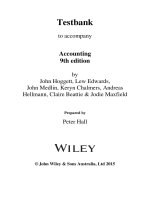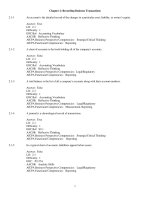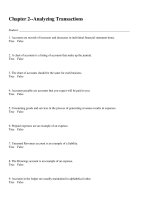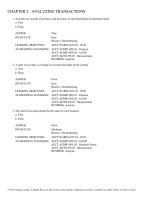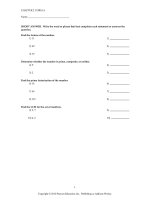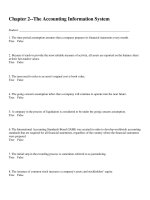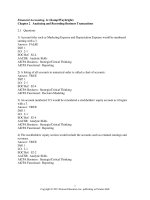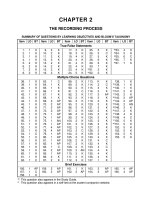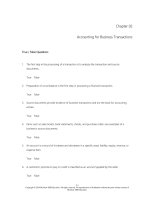Managerial accounting 2nd edition whitecotton test bank
Bạn đang xem bản rút gọn của tài liệu. Xem và tải ngay bản đầy đủ của tài liệu tại đây (9.98 MB, 196 trang )
Chapter 02
Job Order Costing
True / False Questions
1.
Process costing is used when all of the products produced are unique.
True
2.
A marketing consulting firm would most likely use process costing.
True
3.
False
When job order costing is used, costs are accumulated on a job cost sheet.
True
5.
False
A law firm would most likely use job order costing.
True
4.
False
False
Process costing averages the total cost of the process over the number of units produced.
True
False
2-1
© 2014 by McGraw-Hill Education. This is proprietary material solely for authorized instructor use. Not authorized for sale or distribution
in any manner. This document may not be copied, scanned, duplicated, forwarded, distributed, or posted on a website, in whole or part.
6.
Source documents are used to assign all manufacturing costs to jobs.
True
7.
A materials requisition form is used to authorize the purchase of direct materials.
True
8.
False
Direct labor costs are recorded using labor time tickets.
True
9.
False
False
A job cost sheet will record the direct materials and direct labor used by the job but not the
manufacturing overhead applied.
True
False
10. A predetermined overhead rate is calculated by dividing estimated total manufacturing overhead
cost by estimated units in the allocation base.
True
False
11. The predetermined overhead rate is estimated at the end of the period and used to assign
manufacturing overhead to jobs that were completed during the period.
True
False
12. Allocation base and cost driver are two terms that can often be used interchangably.
True
False
2-2
© 2014 by McGraw-Hill Education. This is proprietary material solely for authorized instructor use. Not authorized for sale or distribution
in any manner. This document may not be copied, scanned, duplicated, forwarded, distributed, or posted on a website, in whole or part.
13. The Raw Materials Inventory account shows the cost of only direct materials purchased during the
period.
True
False
14. Indirect materials are recorded directly on the job cost sheet.
True
False
15. Labor that can be traced to a specific job is recorded directly on the job cost sheet.
True
False
16. When manufacturing overhead is applied to a job, a credit is made to the Work in Process
account.
True
False
17. When goods are completed, a debit is made to Work in Process Inventory and a credit is made to
Finished Goods Inventory.
True
False
18. The total manufacturing cost for a job is based on the amount of applied overhead using the
predetermined overhead rate.
True
False
19. Actual manufacturing overhead costs are debited to the Manufacturing Overhead account.
True
False
2-3
© 2014 by McGraw-Hill Education. This is proprietary material solely for authorized instructor use. Not authorized for sale or distribution
in any manner. This document may not be copied, scanned, duplicated, forwarded, distributed, or posted on a website, in whole or part.
20. Commissions expense and advertising expense are included as part of manufacturing overhead
and treated as a product cost.
True
False
21. If there is a debit balance in the Manufacturing Overhead account at the end of the period,
overhead was underapplied.
True
False
22. The most common method for disposing of the balance in Manufacturing Overhead is to make a
direct adjustment to Cost of Goods Sold.
True
False
23. To eliminate underapplied overhead at the end of the year, Manufacturing Overhead would be
debited and Cost of Goods Sold would be credited.
True
False
24. To eliminate underapplied overhead at the end of the year, Manufacturing Overhead would be
credited and Cost of Goods Sold would be debited.
True
False
25. The total amount of cost assigned to jobs that were completed during the year is the cost of
goods sold.
True
False
2-4
© 2014 by McGraw-Hill Education. This is proprietary material solely for authorized instructor use. Not authorized for sale or distribution
in any manner. This document may not be copied, scanned, duplicated, forwarded, distributed, or posted on a website, in whole or part.
26. For service firms, the primary driver used to assign cost is direct material.
True
False
27. In a service firm, the cost associated with time that employees spend on training, paperwork, and
supervision is considered part of manufacturing overhead.
True
False
Multiple Choice Questions
28. Which of the following types of firms would most likely use process costing?
A. Superior Auto Body & Repair
B. Crammond Custom Cabinets
C. Sunshine Soft Drinks
D. Jackson & Taylor Tax Service
29. Which of the following types of firms would most likely use job order costing?
A. Happy-Oh Cereal Company
B. Huey, Lewey & Dewie, Attorneys
C. SoooSweet Beverage
D. C-5 Cement Company
2-5
© 2014 by McGraw-Hill Education. This is proprietary material solely for authorized instructor use. Not authorized for sale or distribution
in any manner. This document may not be copied, scanned, duplicated, forwarded, distributed, or posted on a website, in whole or part.
30. Which of the following is a characteristic of a manufacturing environment that would use job order
costing?
A. Standardized production process
B. Continuous manufacturing
C. Homogenous products
D. Differentiated products
31. The cost of materials used on a specific job is first captured on which source document?
A. Cost driver sheet
B. Materials requisition form
C. Labor time ticket
D. Process cost sheet
32. The source document that captures how much time a worker has spent on various jobs during the
period is a
A. Cost driver sheet.
B. Materials requisition form.
C. Labor time ticket.
D. Job cost sheet.
2-6
© 2014 by McGraw-Hill Education. This is proprietary material solely for authorized instructor use. Not authorized for sale or distribution
in any manner. This document may not be copied, scanned, duplicated, forwarded, distributed, or posted on a website, in whole or part.
33. All the costs assigned to an individual job are summarized on a
A. Cost driver sheet.
B. Job cost sheet.
C. Materials requisition form.
D. Labor time ticket.
34. A predetermined overhead rate is calculated using which formula?
A. Actual manufacturing overhead cost/estimated units in the allocation base
B. Estimated units in the allocation base/estimated manufacturing overhead cost
C. Estimated manufacturing overhead cost/actual units in the allocation base
D. Estimated manufacturing overhead cost/estimated units in the allocation base
35. Manufacturing overhead is applied to each job using which formula?
A. Predetermined overhead rate x actual value of the allocation base for the job
B. Predetermined overhead rate x estimated value of the allocation base for the job
C. Actual overhead rate x estimated value of the allocation base for the job
D. Predetermined overhead rate/actual value of the allocation base for the job
2-7
© 2014 by McGraw-Hill Education. This is proprietary material solely for authorized instructor use. Not authorized for sale or distribution
in any manner. This document may not be copied, scanned, duplicated, forwarded, distributed, or posted on a website, in whole or part.
36. Manufacturing overhead was estimated to be $400,000 for the year along with 20,000 direct labor
hours. Actual manufacturing overhead was $415,000, actual labor hours were 21,000. The
predetermined manufacturing overhead rate would be
A. $20.00
B. $0.05
C. $20.75
D. $19.05
37. Manufacturing overhead was estimated to be $400,000 for the year along with 20,000 direct labor
hours. Actual manufacturing overhead was $415,000, actual labor hours were 21,000. The amount
of manufacturing overhead applied to production would be
A. $400,000
B. $415,000
C. $420,000
D. $435,750
38. Manufacturing overhead was estimated to be $200,000 for the year along with 20,000 direct labor
hours. Actual manufacturing overhead was $215,000, actual labor hours were 21,000. The
predetermined overhead rate would be
A. $10.00
B. $1.05
C. $10.75
D. $10.24
2-8
© 2014 by McGraw-Hill Education. This is proprietary material solely for authorized instructor use. Not authorized for sale or distribution
in any manner. This document may not be copied, scanned, duplicated, forwarded, distributed, or posted on a website, in whole or part.
39. Manufacturing overhead was estimated to be $200,000 for the year along with 20,000 direct labor
hours. Actual manufacturing overhead was $215,000, actual labor hours were 21,000. The amount
of manufacturing overhead applied to production would be
A. $200,000
B. $215,000
C. $210,000
D. $225,750
40. Manufacturing overhead was estimated to be $500,000 for the year along with 20,000 direct labor
hours. Actual manufacturing overhead was $450,000, actual direct labor hours were 19,000. The
predetermined overhead rate would be
A. $22.50
B. $25.00
C. $23.68
D. $26.32
41. Manufacturing overhead was estimated to be $500,000 for the year along with 20,000 direct labor
hours. Actual manufacturing overhead was $450,000, actual direct labor hours were 19,000. The
amount of manufacturing overhead applied to production would be
A. $500,000
B. $450,000
C. $427,500
D. $475,000
2-9
© 2014 by McGraw-Hill Education. This is proprietary material solely for authorized instructor use. Not authorized for sale or distribution
in any manner. This document may not be copied, scanned, duplicated, forwarded, distributed, or posted on a website, in whole or part.
42. Kilt Company had the following information for the year:
Kilt Company used a predetermined overhead rate of $42 per direct labor hour for the year and
estimated that direct labor hours would total 5,500 hours. Assume the only inventory balance is an
ending Work in Process balance of $17,000. How much overhead was applied during the year?
A. $231,000
B. $150,000
C. $166,000
D. $210,000
43. Sawyer Company had the following information for the year:
Sawyer Company used a predetermined overhead rate using estimated overhead of $320,000 and
8,000 estimated direct labor hours. Assume the only inventory balance is an ending Finished
Goods balance of $9,000. How much overhead was applied during the year?
A. $245,000
B. $273,000
C. $280,000
D. $320,000
2-10
© 2014 by McGraw-Hill Education. This is proprietary material solely for authorized instructor use. Not authorized for sale or distribution
in any manner. This document may not be copied, scanned, duplicated, forwarded, distributed, or posted on a website, in whole or part.
44. Jackson Company had the following information for the year:
Jackson Company used a predetermined overhead rate using estimated overhead of $320,000 and
8,000 estimated direct labor hours. Assume the only inventory balance is an ending Finished
Goods balance of $19,000. How much overhead was applied during the year?
A. $245,000
B. $343,000
C. $360,000
D. $320,000
45. Which of the following represents the cost of materials purchased but not yet issued to
production?
A. Raw Materials Inventory
B. Work in Process Inventory
C. Finished Goods Inventory
D. Cost of Goods Sold
46. Which of the following represents the accumulated costs of jobs as yet incomplete?
A. Raw Materials Inventory
B. Work in Process Inventory
C. Finished Goods Inventory
D. Cost of Goods Sold
2-11
© 2014 by McGraw-Hill Education. This is proprietary material solely for authorized instructor use. Not authorized for sale or distribution
in any manner. This document may not be copied, scanned, duplicated, forwarded, distributed, or posted on a website, in whole or part.
47. Which of the following represents the cost of jobs completed but not yet sold?
A. Raw Materials Inventory
B. Work in Process Inventory
C. Finished Goods Inventory
D. Cost of Goods Sold
48. Which of the following represents the cost of the jobs sold during the period?
A. Raw Materials Inventory
B. Work in Process Inventory
C. Finished Goods Inventory
D. Cost of Goods Sold
49. When manufacturing overhead is applied to production, which of the following accounts is
credited?
A. Raw Materials Inventory
B. Work in Process Inventory
C. Finished Goods Inventory
D. Manufacturing Overhead
50. When materials are purchased, which of the following accounts is debited?
A. Raw Materials Inventory
B. Work in Process Inventory
C. Finished Goods Inventory
D. Cost of Goods Sold
2-12
© 2014 by McGraw-Hill Education. This is proprietary material solely for authorized instructor use. Not authorized for sale or distribution
in any manner. This document may not be copied, scanned, duplicated, forwarded, distributed, or posted on a website, in whole or part.
51. When direct materials are used in production, which of the following accounts is debited?
A. Raw Materials Inventory
B. Work in Process Inventory
C. Finished Goods Inventory
D. Cost of Goods Sold
52. When direct materials are used in production, which of the following accounts is credited?
A. Raw Materials Inventory
B. Work in Process Inventory
C. Finished Goods Inventory
D. Cost of Goods Sold
53. When units are completed, the cost associated with the job is credited to which account?
A. Raw Materials Inventory
B. Work in Process Inventory
C. Finished Goods Inventory
D. Cost of Goods Sold
54. When units are sold, the cost associated with the units is credited to which account?
A. Raw Materials Inventory
B. Work in Process Inventory
C. Finished Goods Inventory
D. Cost of Goods Sold
2-13
© 2014 by McGraw-Hill Education. This is proprietary material solely for authorized instructor use. Not authorized for sale or distribution
in any manner. This document may not be copied, scanned, duplicated, forwarded, distributed, or posted on a website, in whole or part.
55. When units are completed, the cost associated with the job is debited to which account?
A. Raw Materials Inventory
B. Work in Process Inventory
C. Finished Goods Inventory
D. Cost of Goods Sold
56. When units are sold, the cost associated with the units is debited to which account?
A. Raw Materials Inventory
B. Work in Process Inventory
C. Finished Goods Inventory
D. Cost of Goods Sold
57. When materials are placed into production,
A. Raw Materials Inventory is debited if the materials are traced directly to the job.
B. Work in Process Inventory is debited if the materials are traced directly to the job.
C. Manufacturing Overhead is debited if the materials are traced directly to the job.
D. Raw Materials Inventory is credited only if the materials are traced directly to the job, otherwise
manufacturing overhead is credited.
58. If materials being placed into production are not traced to a specific job,
A. Raw Materials Inventory would be debited.
B. Work in Process Inventory would be debited.
C. Manufacturing Overhead would be debited.
D. Manufacturing Overhead would be credited.
2-14
© 2014 by McGraw-Hill Education. This is proprietary material solely for authorized instructor use. Not authorized for sale or distribution
in any manner. This document may not be copied, scanned, duplicated, forwarded, distributed, or posted on a website, in whole or part.
59. In recording the purchase of materials that are not traced to any specific job, which of the
following is correct?
A. Raw Materials Inventory would be debited
B. Work in Process Inventory would be debited
C. Manufacturing Overhead would be debited
D. Manufacturing Overhead would be credited
60. Which of the following would be used to record the labor cost that is traceable to a specific job?
A. Raw Materials Inventory would be debited
B. Work in Process Inventory would be debited
C. Manufacturing Overhead would be debited
D. Manufacturing Overhead would be credited
61. Which of the following would be used to record the labor cost that is not traceable to a specific
job?
A. Raw Materials Inventory would be debited
B. Work in Process Inventory would be debited
C. Manufacturing Overhead would be debited
D. Manufacturing Overhead would be credited
2-15
© 2014 by McGraw-Hill Education. This is proprietary material solely for authorized instructor use. Not authorized for sale or distribution
in any manner. This document may not be copied, scanned, duplicated, forwarded, distributed, or posted on a website, in whole or part.
62. Which of the following would be used to record the usage of indirect manufacturing resources?
A. Raw Materials Inventory would be debited
B. Work in Process Inventory would be debited
C. Manufacturing Overhead would be debited
D. Manufacturing Overhead would be credited
63. Which of the following would be used to record the depreciation of manufacturing equipment?
A. Raw Materials Inventory would be debited
B. Work in Process Inventory would be debited
C. Manufacturing Overhead would be debited
D. Manufacturing Overhead would be credited
64. Which of the following would be used to record the property taxes on a factory building?
A. Raw Materials Inventory would be debited
B. Work in Process Inventory would be debited
C. Manufacturing Overhead would be debited
D. Manufacturing Overhead would be credited
65. Which of the following would be used to record the factory supervisor's salary?
A. Raw Materials Inventory would be debited
B. Work in Process Inventory would be debited
C. Manufacturing Overhead would be debited
D. Manufacturing Overhead would be credited
2-16
© 2014 by McGraw-Hill Education. This is proprietary material solely for authorized instructor use. Not authorized for sale or distribution
in any manner. This document may not be copied, scanned, duplicated, forwarded, distributed, or posted on a website, in whole or part.
66. Which of the following would be used to apply manufacturing overhead to production for the
period?
A. Raw Materials Inventory would be debited
B. Work in Process Inventory would be debited
C. Manufacturing Overhead would be debited
D. Work in Process Inventory would be credited
67. Which of the following would be used to apply manufacturing overhead to production for the
period?
A. Credit to Raw Materials Inventory
B. Credit to Work in Process Inventory
C. Debit to Manufacturing Overhead
D. Credit to Manufacturing Overhead
68. Which of the following would be used to transfer the cost of completed goods during the period?
A. Credit to Raw Materials Inventory
B. Credit to Work in Process Inventory
C. Debit to Manufacturing Overhead
D. Credit to Manufacturing Overhead
2-17
© 2014 by McGraw-Hill Education. This is proprietary material solely for authorized instructor use. Not authorized for sale or distribution
in any manner. This document may not be copied, scanned, duplicated, forwarded, distributed, or posted on a website, in whole or part.
69. If a company uses a predetermined overhead rate, which of the following statements is correct?
A. Manufacturing Overhead will be debited for estimated overhead
B. Manufacturing Overhead will be credited for estimated overhead
C. Manufacturing Overhead will be debited for actual overhead
D. Manufacturing Overhead will be credited for actual overhead
70. Which of the following accounts is not affected by applied manufacturing overhead?
A. Raw Materials Inventory
B. Work in Process Inventory
C. Finished Goods Inventory
D. Cost of Goods Sold
71. Manufacturing overhead was estimated to be $400,000 for the year along with 20,000 direct labor
hours. Actual manufacturing overhead was $415,000, and actual labor hours were 21,000. The
amount debited to the Manufacturing Overhead account would be
A. $400,000
B. $415,000
C. $420,000
D. $435,750
2-18
© 2014 by McGraw-Hill Education. This is proprietary material solely for authorized instructor use. Not authorized for sale or distribution
in any manner. This document may not be copied, scanned, duplicated, forwarded, distributed, or posted on a website, in whole or part.
72. Manufacturing overhead was estimated to be $400,000 for the year along with 20,000 direct labor
hours. Actual manufacturing overhead was $415,000, and actual labor hours were 21,000. The
amount credited to the Manufacturing Overhead account would be
A. $400,000
B. $415,000
C. $420,000
D. $435,750
73. Manufacturing overhead was estimated to be $200,000 for the year along with 20,000 direct labor
hours. Actual manufacturing overhead was $215,000, and actual labor hours were 21,000. The
amount debited to the Manufacturing Overhead account would be
A. $200,000
B. $215,000
C. $210,000
D. $225,750
74. Manufacturing overhead was estimated to be $200,000 for the year along with 20,000 direct labor
hours. Actual manufacturing overhead was $215,000, and actual labor hours were 21,000. The
amount credited to the Manufacturing Overhead account would be
A. $200,000
B. $215,000
C. $210,000
D. $225,750
2-19
© 2014 by McGraw-Hill Education. This is proprietary material solely for authorized instructor use. Not authorized for sale or distribution
in any manner. This document may not be copied, scanned, duplicated, forwarded, distributed, or posted on a website, in whole or part.
75. Overhead was estimated to be $250,000 for the year along with 20,000 direct labor hours. Actual
overhead was $225,000, and actual direct labor hours were 19,000. The amount debited to the
manufacturing overhead account would be
A. $250,000
B. $225,000
C. $213,750
D. $237,500
76. Manufacturing overhead was estimated to be $250,000 for the year along with 20,000 direct labor
hours. Actual manufacturing overhead was $225,000, and actual direct labor hours were 19,000.
The amount credited to the Manufacturing Overhead account would be
A. $250,000
B. $225,000
C. $213,750
D. $237,500
77. Overhead costs are overapplied if the amount applied to Work in Process is
A. greater than estimated overhead.
B. less than estimated overhead.
C. greater than actual overhead incurred.
D. less than actual overhead incurred.
2-20
© 2014 by McGraw-Hill Education. This is proprietary material solely for authorized instructor use. Not authorized for sale or distribution
in any manner. This document may not be copied, scanned, duplicated, forwarded, distributed, or posted on a website, in whole or part.
78. Overhead costs are underapplied if the amount applied to Work in Process is
A. greater than estimated overhead.
B. less than estimated overhead.
C. greater than actual overhead incurred.
D. less than actual overhead incurred.
79. Manufacturing overhead was estimated to be $400,000 for the year along with 20,000 direct labor
hours. Actual manufacturing overhead was $415,000, and actual labor hours were 21,000. Which of
the following would be correct?
A. Overhead is underapplied by $15,000
B. Overhead is underapplied by $5,000
C. Overhead is overapplied by $5,000
D. Overhead is overapplied by $15,000
80. Manufacturing overhead was estimated to be $200,000 for the year along with 20,000 direct labor
hours. Actual manufacturing overhead was $215,000, and actual labor hours were 21,000. Which of
the following would be correct?
A. Overhead is underapplied by $15,000
B. Overhead is underapplied by $5,000
C. Overhead is overapplied by $5,000
D. Overhead is overapplied by $15,000
2-21
© 2014 by McGraw-Hill Education. This is proprietary material solely for authorized instructor use. Not authorized for sale or distribution
in any manner. This document may not be copied, scanned, duplicated, forwarded, distributed, or posted on a website, in whole or part.
81. Manufacturing overhead was estimated to be $250,000 for the year along with 20,000 direct labor
hours. Actual manufacturing overhead was $225,000, and actual direct labor hours were 19,000.
Which of the following would be correct?
A. Overhead is underapplied by $25,000
B. Overhead is underapplied by $12,500
C. Overhead is overapplied by $12,500
D. Overhead is overapplied by $25,000
82. The most common method for disposing of over- or underapplied overhead is to
A. recalculate the overhead rate for the period.
B. recalculate the overhead rate for the next period.
C. make a direct adjustment to Work in Process Inventory.
D. make a direct adjustment to Cost of Goods Sold.
83. When disposed of, overapplied manufacturing overhead will
A. increase Cost of Goods Sold.
B. increase Finished Goods.
C. decrease Cost of Goods Sold.
D. decrease Finished Goods.
2-22
© 2014 by McGraw-Hill Education. This is proprietary material solely for authorized instructor use. Not authorized for sale or distribution
in any manner. This document may not be copied, scanned, duplicated, forwarded, distributed, or posted on a website, in whole or part.
84. When disposed of, underapplied manufacturing overhead will
A. increase Cost of Goods Sold.
B. increase Finished Goods.
C. decrease Cost of Goods Sold.
D. decrease Finished Goods.
85. Underapplied overhead means
A. too little overhead was applied to raw materials.
B. actual overhead is greater than estimated overhead.
C. finished goods will need to be credited.
D. there is a debit balance remaining in the overhead account.
86. Manufacturing overhead was estimated to be $400,000 for the year along with 20,000 direct labor
hours. Actual manufacturing overhead was $415,000, and actual labor hours were 21,000. To
dispose of the balance in the Manufacturing Overhead account, which of the following would be
correct?
A. Cost of Goods Sold would be credited for $15,000
B. Cost of Goods Sold would be credited for $5,000
C. Cost of Goods Sold would be debited for $5,000
D. Cost of Goods Sold would be debited for $15,000
2-23
© 2014 by McGraw-Hill Education. This is proprietary material solely for authorized instructor use. Not authorized for sale or distribution
in any manner. This document may not be copied, scanned, duplicated, forwarded, distributed, or posted on a website, in whole or part.
87. Manufacturing overhead was estimated to be $400,000 for the year along with 20,000 direct labor
hours. Actual manufacturing overhead was $415,000, and actual labor hours were 21,000. To
dispose of the balance in the Manufacturing Overhead account, which of the following would be
correct?
A. Manufacturing Overhead would be credited for $5,000
B. Manufacturing Overhead would be credited for $20,000
C. Manufacturing Overhead would be debited for $5,000
D. Manufacturing Overhead would be debited for $20,000
88. Manufacturing overhead was estimated to be $200,000 for the year along with 20,000 direct labor
hours. Actual manufacturing overhead was $215,000, and actual labor hours were 21,000. To
dispose of the balance in the Manufacturing Overhead account, which of the following would be
correct?
A. Cost of Goods Sold would be credited for $15,000
B. Cost of Goods Sold would be credited for $5,000
C. Cost of Goods Sold would be debited for $5,000
D. Cost of Goods Sold would be debited for $15,000
89. Manufacturing overhead was estimated to be $200,000 for the year along with 20,000 direct labor
hours. Actual manufacturing overhead was $215,000, and actual labor hours were 21,000. To
dispose of the balance in the Manufacturing Overhead account, which of the following would be
correct?
A. Manufacturing Overhead would be credited for $5,000
B. Manufacturing Overhead would be credited for $15,000
C. Manufacturing Overhead would be debited for $5,000
D. Manufacturing Overhead would be debited for $15,000
2-24
© 2014 by McGraw-Hill Education. This is proprietary material solely for authorized instructor use. Not authorized for sale or distribution
in any manner. This document may not be copied, scanned, duplicated, forwarded, distributed, or posted on a website, in whole or part.
90. Manufacturing overhead was estimated to be $250,000 for the year along with 20,000 direct labor
hours. Actual manufacturing overhead was $225,000, and actual direct labor hours were 19,000. To
dispose of the balance in the Manufacturing Overhead account, which of the following would be
correct?
A. Cost of Goods Sold would be credited for $25,000
B. Cost of Goods Sold would be credited for $12,500
C. Cost of Goods Sold would be debited for $12,500
D. Cost of Goods Sold would be debited for $25,000
91. Manufacturing overhead was estimated to be $250,000 for the year along with 20,000 direct labor
hours. Actual manufacturing overhead was $225,000, and actual direct labor hours were 19,000. To
dispose of the balance in the Manufacturing Overhead account, which of the following would be
correct?
A. Manufacturing Overhead would be credited for $12,500
B. Manufacturing Overhead would be credited for $25,000
C. Manufacturing Overhead would be debited for $12,500
D. Manufacturing Overhead would be debited for $25,000
92. Cost of goods manufactured is the amount of cost transferred
A. out of Finished Goods Inventory and into Cost of Goods Sold.
B. out of Finished Goods Inventory and into Work in Process Inventory.
C. out of Work in Process Inventory and into Manufacturing Overhead.
D. out of Work in Process Inventory and into Finished Goods Inventory.
2-25
© 2014 by McGraw-Hill Education. This is proprietary material solely for authorized instructor use. Not authorized for sale or distribution
in any manner. This document may not be copied, scanned, duplicated, forwarded, distributed, or posted on a website, in whole or part.
